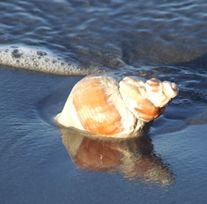
After finishing the newspaper I tried to watch a movie, but I couldn’t concentrate. I turned off the movie and picked up the book off the top my pile of newly acquired second hand paperbacks and decided to try to read ‘A History of the English Church and People’ by Bede. Note the word try. The book was completed in 731. That’s not a typo…it was written centuries before William the Conqueror arived to savage England. It may not be boring, but it’s not sold as a page turner! I made it to the end of the first page. Bede, begins by telling the reader about Britain. Where it is, how large it is and what sort of animals can be found here etc. I was starting to fall asleep until I read, “There are also many varieties of shell-fish, such as mussels, in which are often found excellent pearls of several colours, red, purple, violet, and green, but mainly white.” (Have you ever heard of green or violet pearls? I haven’t. I made a mental note to look it up and continued…) “Whelks are abundant, and a beautiful scarlet dye is extracted from them which remains unfaded by sunshine or rain; indeed, the older the cloth, the more beautiful the colour.” Wondering what a whelk was, I looked it up in my encyclopaedia…
It mentioned it was a type of sea mussle, but there was nothing about a dye or what part of the creature created the dye which is what I wanted to know. The artist and fashion designer in me finds different dyes interesting so I looked up “Whelk + scarlet” and found an article in the Cambridge Journal that looked like it might illuminate me, but I didn’t want to pay $15 to be illuminated so I kept looking and ended up reading an article about the first comprehensive dictionary of colour terms written by Antonio Telesio. He wrote his Booklet on Colours (it was only about 4000 words long) in 1528 not for painters, but for writers of poetry and pose (who like himself) wanted to use accurate colour descriptions in their writing. He related his colour terms and dye sources by quoting numerous classical authors so it’s like a small history of colour as well as a dictionary. Still wondering what what part of a whelk causes the scarlet dye I skimmed to the end of the article and found that in 1810 (the Regency) a JW von Goethe (The Goethe) included Antonio Telesio’s booklet on colour in his Theory of Colour. Did you know the same man who wrote that late Georgian best selling romance ‘The Sorrows of Young Werther’ also wrote a book on the theory of colour?
I now want to read Goethe’s Theory of Colour. Telesio’s booklet was translated by Don Pavey and published in 2000. I want a copy! I still don’t know what type of whelk (or part) was used to make Bede’s scarlet dye, but I’ll keep looking. Surely someone somewhere in England is still harvesting whelks for the scarlet dye…you’d think. Apparently tons have been harvested every year for the Korean market where whelks are considered an aphrodisiac. Hmmm? I wonder what they taste like?
I may not know what I wanted to know, but I know about Telesio’s booklet and Goeth’s Theory of Colour. Who knows what I may find. I suspect there’s a story lurking out of sight…
I wonder what else I’ll learn from Bede? If I can stay awake I might learn something!
